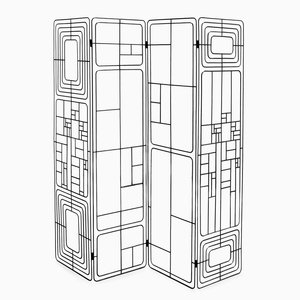Sara Bernardi shares her passion for contradiction
New Frameworks
Italian architect Sara Bernardi's Con-Tradition Screens manifest a surprising and clever synergy of material and form. Like many architect-designed objects for use, these folding screens have a deliberately stripped-down appearance that nonetheless communicates an air of refined elegance. Upon closer inspection, however, their material composition turns out to be raw and brutalist segments of steel rebar—a basic and unglamorous ingredient of modern building construction—arranged and welded together to form graphic, three-dimensional patterns that recall the modernist work of Frank Lloyd Wright and Piet Mondrian.
Contradictions like these are a central theme in Bernardi‘s design work. On the occasion of launching her pieces in our Shop, we reached out to Bernardi to learn more about her move to Beijing—where she established her studio in 2012— and her attraction to design anomalies and eroded surfaces.
P: You opened your studio in Beijing in 2012, after having lived and worked in China for a couple of years. What made you decide to settle there?
SB: I was in New York working for Fuksas when I was asked to fly over to Shenzhen and start working on the new Airport project. That was my first time in China; my first encounter with the fast-growing, fast-developing architectural environment there. It was a very strong cultural twist for me. I immediately felt that China was the place to be.
Beijing is both very international and extremely Chinese at the same time. It is a field of creative experimentation, with a vibrant energy that you can hardly find anywhere else. The strong ties to the past with the determined race toward the future is what impressed me the most. [From] there comes my inspiration to work on the relations between East and West—by mixing and grafting together the contemporary and the historical.
P: The Con-Tradition collection plays with juxtapositions: traditional Chinese furniture forms with a contemporary, Western style, at once both elegant and raw. Tell us the story behind this approach.
SB: The Con-Tradition collection comes from my discovery and study of Chinese heritage. It started from observations I made about some archetypes, not only of the furniture tradition but of Chinese culture itself—the lanterns, which through the centuries have seen many variations; the folding screens, which embody the "ghost wall" tradition from Feng Shui; the altar table used for the art of calligraphy; the low table for the tea ceremony; and the ubiquitous stools. I wanted to challenge the apparent contradiction between the reductionism of contemporary and minimalist language and the richness found in Chinese cultural heritage.
By using raw construction materials, like concrete and steel rebar, I tried to force a reaction between the materiality’s roughness and strength and the elegance of the antique forms. Concrete and steel since their beginnings have been ubiquitous symbols of urbanization—and, even more so, metaphors for modernity that conflict with the value of heritage.
P: You work a lot with steel rebar. What's its aesthetic appeal for you?
SB: As an architect my work obviously has an essential link to concrete and steel, but my personal approach focuses on the displacement of scales and identities. I like the roughness of raw materials; I collect photographs of concrete patterns and of metals eroded by atmospherical agents. Most of the Chinese construction sites are enclosed in a standard blue metal fence, beautifully patterned with rust. I always look at it wondering in which project I could use it. Maybe this is linked to my Roman origin and a certain attraction to and familiarity with ruin, materiality, and stratification.
Steel rebar has an additional appeal to me. When you look at it from close you perceive the strength of the material and the subtle vibration of the spiral rib. But if you look [at] it from afar, you realize the tremendous graphic quality of these lines drawn in space, casting sharp yet subtle shadows on the walls.
Thank you so much for this conversation, Sara!



